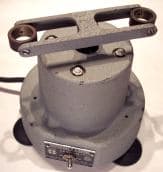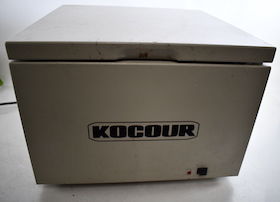
-----
Centrifuging to separate Titanium from Nitric Acid
 (old fashioned centrifuge for 2 test tubes)
(old fashioned centrifuge for 2 test tubes) Quickstart:
A centrifuge is a device designed to quickly separate heavier materials from lighter ones by spinning the material to develop centrifugal force. Usually at least one of the materials is a liquid, and due to the high g forces resulting from the spinning, the heavier material is forced outward and the lighter material forced inward.
Centrifuges can be designed in several different arrangements. A laboratory centrifuge, for example. might hold 2 or 4 test tubes and be used to force a precipitate to the bottom of the tubes. Other centrifuges might employ a torus (donut) shaped bowl, and force the heavier material towards the outside of the donut. Such centrifuges can be used in continuous fashion as a sort of filter, where any heavy particles are flung out of the continuous liquid stream so the overflowing liquid is free of heavy particles.
Q. Titanium and Nitric acid are made to flow through a pipe to a centrifugal bowl rotating at 4450 RPM. What mechanism can be used to separate titanium and nitric acid so that the titanium is deposited in the inside surface of the bowl and nitric acid is allowed to flow out of the bowl.
Denesh Natarajan- Manchester, U.K.
2003
A. Hi, Denesh. This reads like a homework question rather than a real-world problem. Readers can help you with the answers to your questions -- the answer here is probably "centrifugal force". But if you don't understand the question, that's a matter best discussed with your teacher. I suggest you look into what a centrifugal bowl or centrifuge is, and what they do and why, because answers will do you no actual good if you don't understand the question. Good luck!

Ted Mooney, P.E.
Striving to live Aloha
finishing.com - Pine Beach, New Jersey
Ted can be retained for immediate
answers or long term project help
A. It is a special centrifuge for that purpose. Centrifugal force holds the heavier metal to the side of the bowl and allows the acid to slowly spill over the top and drain into a proper container.
James Watts- Navarre, Florida
A. Is the titanium solid or in solution? Please give more precise details as to what you have. You cannot electrodeposit titanium from an aqueous solution. Your only chance of depositing titanium on the inside of the bowl is to filter it off as a solid and vacuum deposit it onto the bowl, but I suspect this is totally impractical. Doing this will also separate the titanium from the nitric acid.

Trevor Crichton
R&D practical scientist
Chesham, Bucks, UK
Q, A, or Comment on THIS thread -or- Start a NEW Thread
